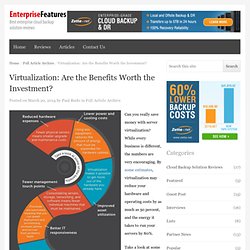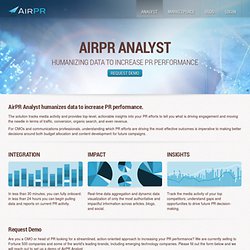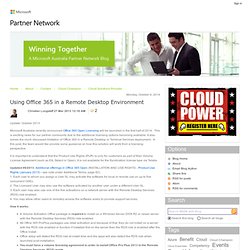

Exchange 2013 virtualization: Exchange 2013 Help. Applies to: Exchange Server 2013 Topic Last Modified: 2014-01-23 You can deploy Microsoft Exchange Server 2013 in a virtualized environment.

This topic provides an overview of the scenarios that are supported for deploying Exchange 2013 on hardware virtualization software. Contents The following terms are used in this discussion of Exchange virtualization: Cold boot When bringing a system from a power-off state into a clean start of the operating system, the action is a cold boot. Microsoft supports Exchange 2013 in production on hardware virtualization software only when all the following conditions are true: The hardware virtualization software is running one of the following: Any version of Windows Server with Hyper-V technology or Microsoft Hyper-V Server Any third-party hypervisor that has been validated under the Windows Server Virtualization Validation Program. For deployments of Exchange 2013: All Exchange 2013 server roles are supported in a virtual machine. Unified management for Cloud OS with System Center 2012 R2. Virtualization: Are the Benefits Worth the Investment? - Enterprise Features.
Can you really save money with server virtualization?

While every business is different, the numbers are very encouraging. By some estimates, virtualization may reduce your hardware and operating costs by as much as 50 percent, and the energy it takes to run your servers by 80%. Take a look at some of the benefits: Virtualization can make your business more flexible and agile, and by so doing, decrease your IT overhead. Virtualization also positions you to take advantage of cloud computing more easily, should your organization choose to do so.
You Don’t Have to Start Your Virtualization Project from Scratch The good news is, virtualization may be less of an investment than you think. . • Use the IT you already own. AirPR Analyst - PR Data. AirPR Analyst humanizes data to increase PR performance.

The solution tracks media activity and provides top-level, actionable insights into your PR efforts to tell you what is driving engagement and moving the needle in terms of traffic, conversion, organic search, and even revenue. For CMOs and communications professionals, understanding which PR efforts are driving the most effective outcomes is imperative to making better decisions around both budget allocation and content development for future campaigns. Integration In less than 30 minutes, you can fully onboard; in less than 24 hours you can begin pulling data and reports on current PR activity. Impact Real-time data aggregation and dynamic data visualization of only the most authoritative and impactful information across articles, blogs, and social. Insights Track the media activity of your top competitors; understand gaps and opportunities to drive future PR decision-making. Using Office 365 in a Remote Desktop Environment - Official Microsoft Partner Network Blog - Site Home - MSDN Blogs.
Update: October 2013 Microsoft Australia recently announced Office 365 Open Licensing will be launched in the first half of 2014.

This is exciting news for our partner community due to the additional licensing options becoming available. It also solves the much discussed limitation of Office 365 in a Remote Desktop or Terminal Services deployment. Devhammer's Den - Cisco AnyConnect and Hyper-V - Connect to a VPN from Inside a VM Session. May 22, 2014 As regular readers of this blog may be aware, I recently hung up my technical evangelist hat, and made the jump back into full-time consulting.

Consistent with best practices, I decided that when working with a new client, the best course of action would be to set up a new virtual machine to keep all of the development environment, tools, and files isolated from anything on my host machine, which helps minimize the risk that installing the latest bleeding-edge tools (which are good to have to stay ahead of the learning curve) don't endanger the work I'm doing for the client. With my current client, I need to be able to access files, servers, and tools on their remote network, which they enable via the Cisco AnyConnect VPN client software.
So far, so good. I had no trouble at all installing and connecting with this software from my laptop over my FiOS connection. The Tricky Part So, the next step was to try installing the VPN client software in the VM itself. OK, so now what?